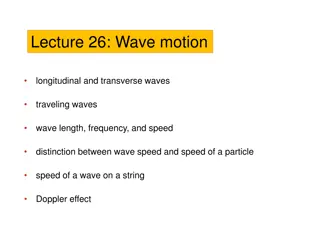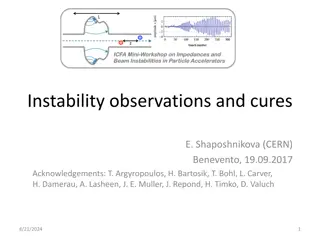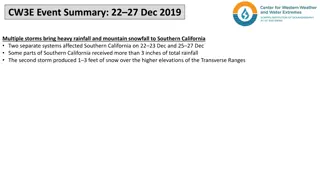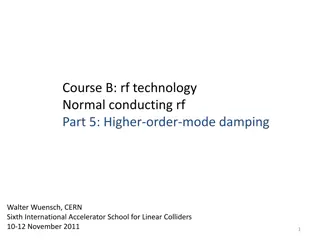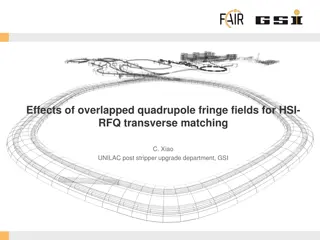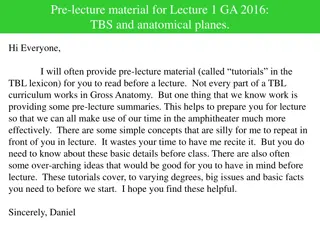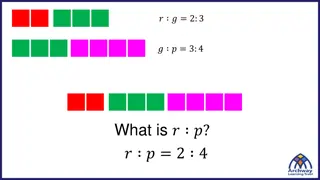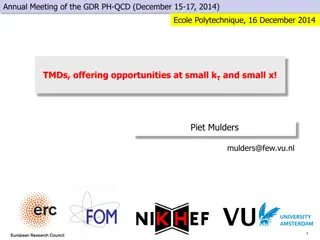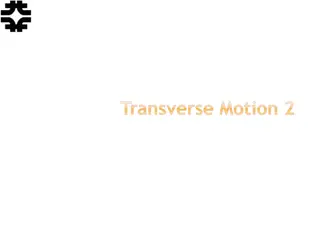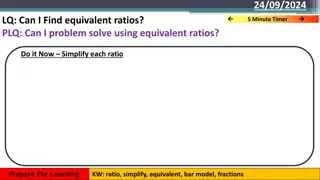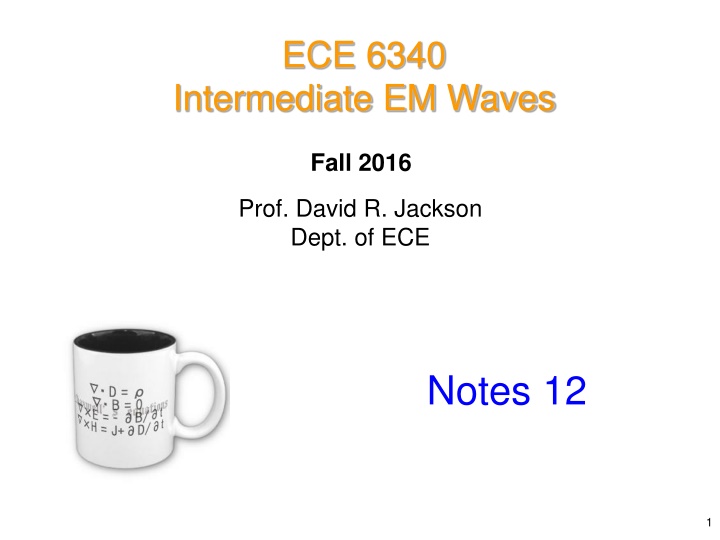
Understanding Intermediate EM Waves Impedance Theory
Explore the concept of wave impedance in intermediate electromagnetic waves, covering topics like wave propagation direction, impedance calculation, transverse equivalent networks, and more.
Download Presentation

Please find below an Image/Link to download the presentation.
The content on the website is provided AS IS for your information and personal use only. It may not be sold, licensed, or shared on other websites without obtaining consent from the author. If you encounter any issues during the download, it is possible that the publisher has removed the file from their server.
You are allowed to download the files provided on this website for personal or commercial use, subject to the condition that they are used lawfully. All files are the property of their respective owners.
The content on the website is provided AS IS for your information and personal use only. It may not be sold, licensed, or shared on other websites without obtaining consent from the author.
E N D
Presentation Transcript
ECE 6340 Intermediate EM Waves Fall 2016 Prof. David R. Jackson Dept. of ECE Notes 12 1
Wave Impedance Assume TMz wave traveling in the +z direction From previous notes: ( ) + + = z H TM E Z t t ( ( ) + + z E = z H TM z Z so t t ) + + z E = TM Z H or t t ( ) 1 TM k k k + + = z E H = = TM Z z z t t Z c 2
Wave Impedance (cont.) ( ) e + j k z For -z wave: = jk z jk z so we can simply substitute e e z z z k k z z ( ) 1 TM In this formula the wavenumber and the wave impedance are taken to be the same for negative and positive traveling waves. = z E H t t Z ( ) 1 TM + sign: +z wave - sign: - z wave = z E H Summary: t t Z 3
Wave Impedance (cont.) TEzwave: ( ) 1 TE = z E H t t Z k k = = TE Z k z z Note: = 2 TE TM Z Z 4
Transverse Equivalent Network (TEN) Denote = ( , , ) E x y z ( , ) x y V z ( ) E 0 t t where + + = + jk z jk z Note: V(z) behaves as a voltage function. ( ) V z V e V e z z Also, write = e ( , ) x y ( , ) x y ( , ) x y E (assume TMzwave) 0 t TM t Note: We can assume that both the unit vector and the transverse amplitude function are both real (because of the corollary to the real theorem). Hence we have = e ( , , ) E x y z ( , ) x y ( , ) ( ) x y V z t TM t Note: There is still flexibility here, since there can be any real scaling constant in the definition of t. We have not uniquely determined t yet. 5
Transverse Equivalent Network (cont.) For the magnetic field we have ( ) 1 TM ( ) 1 TM = z E + H = z E z E H t t t t t Z Z = e ( , , ) x y z ( , ) x y ( , ) x y V ( ) z E Now use t TM t = jk z ( ) z V V e z 1 TM ( ) + = z e jk z ( , ) x y V e H z t TM t Z The result for the transverse magnetic field is then 1 TM ( ) + z e jk z ( , ) x y V e z TM t Z 6
Transverse Equivalent Network (cont.) Define z e ( , ) x y ( , ) x y h TM TM and + + jk z jk z V e Z V e z z = ( ) I z TM TM Z Note:I(z) behaves as a transmission-line current function. We then have = ( , , ) H x y z ( , ) x y ( , ) ( ) x y I z h t TM t Note: We could also introduce a different characteristic impedance (Z0 ZTM), and then have a different t function for the magnetic field. 7
Transverse Equivalent Network (cont.) Summary = e ( , , ) E x y z ( , ) x y ( , ) ( ) x y V z t TM t = ( , , ) H x y z ( , ) x y ( , ) ( ) x y I z h t TM t + + = + jk z jk z ( ) V z V e V e z z + + jk z jk z V e Z V e Z z z = ( ) I z TM TM z e ( , ) x y ( , ) x y h TM TM 8
Transverse Equivalent Network (cont.) +z Waveguide z -z I(z) + V(z) - Z0= ZTMor ZTE kz = kz of waveguide mode z TEN ( ) ( ) I z V z E H t t 9
Transverse Equivalent Network (cont.) Power flowing in waveguide 1 2 ( = * TEN TEN: P VI 1 2 1 2 1 2 1 2 ) ( ) = E H = * * WG z z z S E H WG: t t = * e z ( , ) x y ( , ) ( ) x y V z ( , ) x y ( , ) x y I z ( ) h TM t TM t ( ) 2 = * e z ( , ) x y VI h TM t TM ( ) z ( ) = z e = = e e z z z 1 h TM TM TM TM ( ) ( ) ( ) B C = A B A C C A B Note: 1 2 2 = * WG z ( , ) x y S VI Hence t 10
Transverse Equivalent Network (cont.) The total complex power flowing down the waveguide is then 1 2 2 = = * WG WG z ( , ) x y P S dS VI dS t S S or 2 = WG TEN ( , ) x y P P dS t S 2 = ( , ) x y dS 1 Note: This uniquely defines t, and hence voltage and current. If we choose t S then = WG TEN P P 11
TEN: Junction z = 0 0 r z Junction: same cross sectional shape At z = 0: ( ) 0 ( ) 0 ( ) 0 ( ) 0 (EM boundary conditions) + + = = E E H H t t t t + + = = (0 ) (0 ) (0 ) (0 ) V V I I Hence + (0 ) I (0 ) I + + V These conditions are also true at a TL junction. TM TM , Z k , Z k + (0 ) V (0 ) 01 1 z 00 0 z - - 12
Example: Rectangular Waveguide y TE10mode incident at a junction #1 r z The TEN method gives us an exact solution since the two WGs have the same cross sectional shape (the same tfunction). x 0 #0 z = 0 b a a TEN: + TE TE Z Z Z Z = 01 TE 00 TE TE , TE Z k , Z k 01 00 01 1 z 00 0 z 1 T T = + 1 13
Example: Rectangular Waveguide (cont.) = = TE 0 0 Z 00 k 2 0 z 2 0 k a Similarly, / k = 0 0 = 2 TE Z 1 01 2 1 k a 1 0 k a 1 = 0 2 1 k a 0 = 376.730313461771 [ ] 0 14
Example (Numerical Results) = = 2.2225 [cm] 1.0319 [cm] a b X-band waveguide f = 10GHz r = 2.2 ( ) teflon Choose cf = 6.749 [GHz] ( ) air -filled guide = = TE TE 510.25 [ ] 285.18 [ ] Z Z 00 01 zk = = 276.87 [rad/m] 154.74 [rad/m] zk 1 0 = = 0.28295 0.71705 The results are: T 15
Example (cont.) ( ) ( ) 2 2 = = = % 100 100 0.28295 8.00 P r = = % 100 8.00 92.0 P (conservation of energy and orthogonality) t = = % ( ) 0 ( ) 0 8.00 P + = P P conservation of energy r z z % 92.0 P ( ) 0 = + inc z ref z P P P othogonality (in Notes 13) t z + = inc z ref z trans z P P P Note: 100 2 = inc z inc z trans z P P P 2 % tP T (This is because the impedances of the two guides are different.) 16
Example (cont.) 2 = WG TEN ( , ) x y P P dS Alternative calculation: t S 2 t 2 V T Z 2 ( , ) x y dS t TE TE 2 Z 2 = = % 01 100 100 01 2 S P t 2 1 Z + V 2 ( , ) x y dS TE 2 t TE 2 Z 00 00 S TE Z Z 2 = % tP = % 100 00 TE P T 92.0 t 01 17
Example (cont.) Fields in the waveguides = e ( , , ) E x y z ( , ) x y ( , ) ( ) x y V z t TE t = ( , , ) H x y z ( , ) x y ( , ) ( ) x y I z h t TE t ( ( ) ) = e y , x y TE TE10 mode: = x , h x y e z ( , ) x y ( , ) x y h TE TE TE x ( ) = , sin x y t a This choice of t does not correspond to equal powers for the WG and the TEN. y #1 r TEN ab z = WG P P x #0 0 2 z = 0 b a V(z)= Eyat the center of the WG a 18
Example (cont.) ( ( ) ) = e y , x y TE = e ( , , ) E x y z ( , ) x y ( , ) ( ) x y V z t h TE t = x , x y TE = ( , , ) H x y z ( , ) x y ( , ) ( ) x y I z h x ( ) t TE t = , sin x y t a TL part ( ) z Air region: = + jk z jk z air V e e 0 0 z z x ( ) 1 TE ( ) = + jk z jk z y ( ) z ( , , ) E x y z sin e e = jk z jk z air 0 0 z z I e e 0 0 z z t a Z 00 ( ) z = jk z diel V Te 1 TE x ( ) 1 z = jk z jk z x ( , , ) H x y z sin e e 0 0 z z 1 TE t ( ) a Z ( ) z = jk z diel I Te 1 z 00 Z 01 Dielectric region: x ( ) y = jk z y ( , , ) E x y z sin #1 Te r 1 z t a z x #0 0 1 TE x ( ) = jk z x z = 0 ( , , ) H x y z sin Te 1 z t b a Z a 01 a 19
Matching Elements A couple of commonly used matching elements: = TE 0 Z 0 10 z k y TEN Lp Z0TE Z0TE x Inductive post (narrow) y TEN Cd Z0TE Z0TE x Capacitive diaphragm (iris) 20
Matching Elements (cont. Note: Planar discontinuities are modeled as purely shunt elements. End view Inductive iris Capacitive iris Resonant iris The equivalent circuit gives us the correct reflection and transmission for the dominant TE10 mode. 21
Discontinuity Rectangular waveguide with a post: Post ap= radius of post TE10 x TE10 TE10 Top view: a z Higher-order mode region Assumption: Only the TE10 mode can propagate. 22
Discontinuity (cont.) x Top view: = TE 0 Z TE10 0 10 z k TE10 = 0 2 z 1 k a Higher-order mode region 0 The element is chosen to give the same reflected and transmitted TE10 waves as in the actual waveguide. TEN: Lp Z0TE Z0TE Note: The discontinuity is approximately a shunt load because the tangential electric field of the dominant mode is approximately continuous, while the tangential magnetic field of the dominant mode is not (shown later). 23
Discontinuity (cont.) Flat strip model (strip of width w) x z= 0+ z= 0- TE10 TE10 w Top view: x0 z Narrow strip model for post (w=4ap) Assume center of post is at x=x0 In this model (flat strip model) the equivalent circuit is exactly a shunt inductor (proof given later). 24
Discontinuity (cont.) x z = 0+ z = 0- TE10 TE10 Top view: w x0 z = + inc y sca y E E E y x 10 z = jk z inc y sin E e a = field produced by strip current sca y E (that is, the field scattered (or radiated) by the strip) 25
Discontinuity (cont.) Transverse fields radiated by the post current (no y variation): m x a m x a By symmetry, the scattered field should have no y variation. ( ) 0 m z + + = jk z sca y , , x y z sin E A e m = 1 m ( ) 0 m z + = jk z sca y , , x y z sin E A e m 1/2 2 = 1 m m = 0 2 0 m z k k a + A Z m x a ( ) 0 m z + = jk z sca x , , x y z sin m TE m H e ( ) 1 TE m = z E H = 1 m 0 t t Z 0 A Z m x a ( ) 0 m z + = jk z sca x , , x y z sin m TE m H e = TE m 0 0 Z = 1 m 0 0 m z k We assume a field representation in terms of TEm0 waveguide modes (therefore, there is only a y component of the electric field). j H jk E = E 0 0 z z z Note: TMm0 modes do not exist. 0 x 2 2 z 2 2 z k k y k k x 26
Discontinuity (cont.) x z= 0+ z= 0- TE10 TE10 Top view: w x0 z x 10 z = jk z inc y sin E e Note: The incident field is continuous at z = 0. a From boundary conditions: ( ) ( ) + = = = 0 0 E z E z y y ( ) ( ) + = = = sca y sca y 0 0 E z E z Hence 27
Discontinuity (cont.) ( 0 y E z = = ) ( ) + = sca sca y 0 E z m x a m x a + = sin sin A A m m = = 1 1 m m Equate terms of the Fourier series: ( ) 0 ( ) 0 ( ) 0 + = = + = = + A A A = 10 10 sca y sca y ( ) 0 A A A E E m m m 1 1 1 + = 10 y 10 y E E Modeling equation: x ( ) 0 ( ) 0 ( ) = + 10 t = sin y E V z V V a 28
Discontinuity (cont.) ( ) 0 ( ) 0 + = V V This establishes that the circuit model for the flat strip must be a parallel (shunt) element. = X L jXp Z0TE Z0TE p p 29
Discontinuity (cont.) The fields inside the waveguide are then: m x a m x a ( ) 0 m z + = 1/2 jk z sca y , , x y z sin E A e 2 m m = 0 2 0 m z k k = 1 m a ( ) 0 m z + = jk z sca y , , x y z sin E A e m = 1 m = TE m 0 0 Z A Z m x a 0 m z k ( ) 0 m z + = jk z sca x , , x y z sin m TE m H e = 1 m 0 A Z m x a ( ) 0 m z + = jk z sca x , , x y z sin m TE m H e = 1 m 0 There is one set of unknown coefficients Am. 30
Discontinuity (cont.) Magnetic field: ( ) ( ) ( ) x + = = = 0 0 H z H z J x x sy From the Fourier series for the magnetic field, we then have: 1 TE m m x a ( ) ( ) x = sin A A J m m sy Note: Z = 1 m We can use the scattered field here, since he incident field is continuous. 0 1 TE m = m x a ( ) ( ) x 2 sin A J or m sy Z = 1 m 0 Represent the strip current as a 2 a m x a m x a ( ) x ( ) x = sin j J dx = sin J j m sy sy m = 1 m 0 31
Discontinuity (cont.) Therefore 2 TE m m x a m x a = sin sin A j m m Z = = 1 1 m m 0 Hence TE m Z = 0 A j m m 2 In order to solve for jm, we need to enforce the condition that Ey= 0 on the strip. 32
Discontinuity (cont.) Assume that the strip is narrow, so that a single Maxwell function describes accurately the shape of the current on the strip: 1/ w w ( ) x I0 is now the unknown. = + J I x x x 0 0 0 sy 2 2 2 w ( ) 2 x x (I0 is the total current on the strip.) 0 2 a 2 a m x a ( ) x = sin j J dx Basis function B(x) m sy 0 Hence + /2 x w 2 a 1/ m x a 0 = sin j I dx 0 m 2 w ( ) /2 x w 2 0 x x 0 2 33
Discontinuity (cont.) 2 a = j I c Hence 0 m m where + /2 x w 1/ m x a 0 sin c dx m 2 w ( ) /2 x w 2 0 x x 0 2 Note:cm can be evaluated in closed form (in terms of the Bessel function J0). m x a m w a = sin 0 c J (Please see the Appendix.) 0 m 2 34
Discontinuity (cont.) The fields inside the waveguide are now given by: m x a m x a ( ) 0 m z + = jk z sca y , , x y z sin E A e m = 1 m ( ) 0 m z + = jk z sca y , , x y z sin E A e m = 1 m A Z m x a ( ) 0 m z + = jk z sca x , , x y z sin m TE m H e = 1 m 0 A Z m x a ( ) 0 m z + = jk z sca x , , x y z sin m TE m H e = 1 m 0 TE m Z m x a m w a 2 a = = = 0 A j sin 0 c J j I c m m 0 m m 0 m 2 2 We still need to solve for the unknown post current I0, by enforcing that the electric field vanish on the strip. 35
Discontinuity (cont.) To solve for I0, enforce the electric field integral equation (EFIE): + = inc y sca y w w 0 E E on strip = + 0, z x x x 0 0 2 2 x ( ) 10 z = jk z inc y , , x y z sin E e (unit-amplitude incident mode) a m x a ( ) 0 m z = jk z sca y , , x y z sin E A e m = 1 m Hence x m x a w w = + sin sin A x x x 0 0 m 2 2 a = 1 m 36
Discontinuity (cont.) x m x a w w = + sin sin A x x x 0 0 m 2 2 a = 1 m TE m Z = 0 A j m m 2 TE m Z x m x a w w = + sin sin 0 j x x x 0 0 m 2 2 2 a = 1 m 2 a = j I c 0 m m TE m 2 a Z x m x a w w = + sin sin 0 c I x x x 0 0 0 m 2 2 2 a = 1 m 37
Discontinuity (cont.) TE m 2 a Z x m x a w w = + sin sin 0 I c x x x 0 0 0 m 2 2 2 a = 1 m This is in the form w w ( ) f x ( ) = + I g x x x x 0 0 0 2 2 To solve for the unknown I0, we can use the idea of a testing function. We multiply both sides by a testing function and then integrate over the strip. + + /2 /2 x w x w 0 0 ( ) ( ) T x f x dx ( ) ( ) T x g x dx = I 0 /2 /2 x w x w 0 0 38
Discontinuity (cont.) + + /2 /2 x w x w TE m 2 a Z x m x a 0 0 ( ) ( ) = sin sin 0 T x dx I c T x dx 0 m 2 a = 1 m /2 /2 x w x w 0 0 Galerkin s method: The testing function is the same as the basis function: 1/ ( ) ( ) = = T x B x 2 w ( ) 2 x x 0 2 39
Discontinuity (cont.) Hence + /2 x w 1/ x 0 sin dx a 2 w ( ) /2 x w 2 0 x x 0 2 + /2 x w TE m 2 a 1/ Z m x a 0 = sin 0 I c dx 0 m 2 2 w = 1 m ( ) /2 x w 2 0 x x 0 2 This integral is cm. 40
Discontinuity (cont.) Hence TE m 2 a Z = 0 c I c c 1 0 m m 2 = 1 m so c = I 1 Z 0 TE m 2 a 2 m c 0 2 = 1 m or ac = I 1 0 2 m TE m Z c 0 = 1 m 41
Discontinuity (cont.) Summary ac = I 1 m x a m w a 0 = sin 0 c J 2 m TE m Z c 0 m 2 0 = 1 m = TE m Z 0 0 0 m z k TE m 2 a Z = = j I c 0 A j 0 m m = m m 0 2 2 m k a 1 0 m x a m x a ( ) 0 m z + = jk z sca y , , x y z sin E A e m = 1 m ( ) 0 m z + = jk z sca y , , x y z sin E A e m = 1 m 42
Discontinuity (cont.) Reflection coefficient: A = = = = 1 A A 1A so 1 1 1 Post reactance: TE + TE jX Z jX Z Z Z Z = 10 Z p + = = 10 TE in TE Z Z jX where 10 in p TE 10 in 10 p Z in = TE = TE Z Z Z Z jXp TEN 0 10 0 10 From these two equations, Xp may be found in terms of . 43
Discontinuity (cont.) Result: + 1 = TE jX Z 10 p 2 where j TE Z = = 10 A 1 1 2 = TE 0 Z 10 2 1 2 a k a = j I c 0 1 0 1 m x a m w a = sin 0 c J 0 m 2 ac = I 1 0 2 m TE m Z c 0 = 1 m 44
Discontinuity (cont.) Results for many different types of waveguide discontinuities may be found in: N. Marcuvitz, The Waveguide Handbook, IET (The Institution of Engineering and Technology), IEE Electromagnetic Wave Series, 1985. (The book was originally published in 1951 as vol. 10 of the MIT Radiation Laboratory series.) 45
Appendix In this appendix we evaluate the cm coefficients. + /2 x w 1/ m x a 0 = sin c dx m 2 w ( ) /2 x w 2 0 x x 0 2 = x x x Use 0 + /2 w m x a x 1 1 = 0 sin c dx m 2 w ( ) x /2 w 2 2 46
Appendix (cont.) + /2 w m x a x 1 1 = 0 sin c dx m 2 w ( ) x /2 w 2 2 or m x a m x a m x a sin cos 0 /2 w 1 1 = c dx m m x a 2 w + ( ) x /2 w cos sin 0 2 2 This term integrates to zero (odd function). 47
Appendix (cont.) /2 w 1 1 m x a m x a = sin cos 0 c dx m 2 w ( ) x /2 w 2 2 or m x a cos /2 w 2sin m x a = 0 c dx m 2 w ( ) x 0 2 2 48
Appendix (cont.) w = sin x Next, use the transformation 2 w = cos dx d 2 m w a w cos sin /2 2 m x a w 2 = sin cos 0 c m 2 cos 0 2 49
Appendix (cont.) /2 2sin m x a m w a = cos sin 0 c d m 2 0 or 1sin m x a m w a = cos sin 0 c d m 2 0 Next, use the following integral identify for the Bessel function: 1 ( ) z ( ) = cos sin n J z n d 0 so that 1 ( ) z ( ) = cos sin J z d 0 0 50





